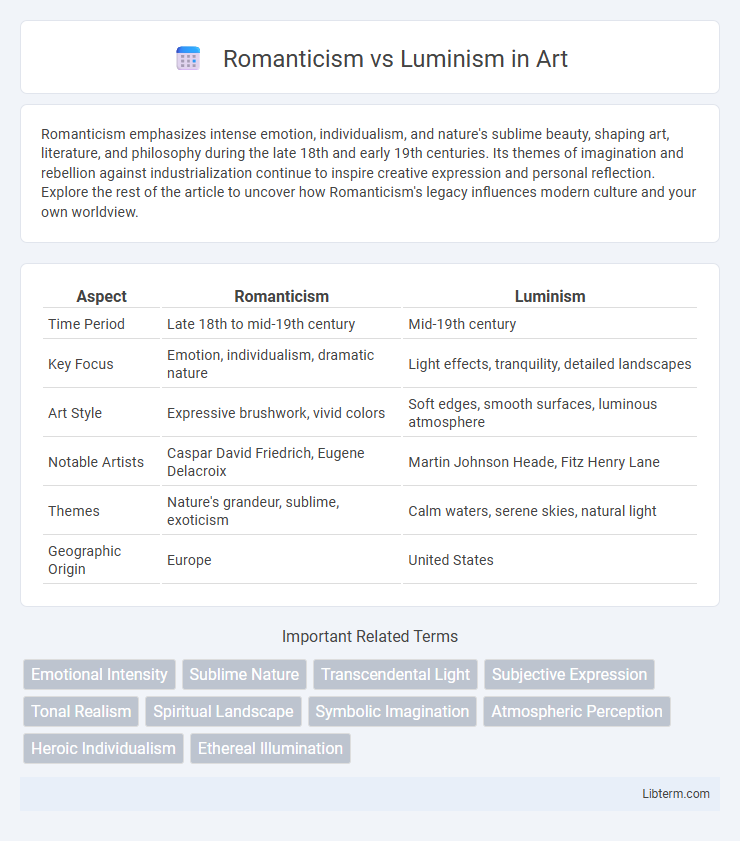Romanticism emphasizes intense emotion, individualism, and nature's sublime beauty, shaping art, literature, and philosophy during the late 18th and early 19th centuries. Its themes of imagination and rebellion against industrialization continue to inspire creative expression and personal reflection. Explore the rest of the article to uncover how Romanticism's legacy influences modern culture and your own worldview.
Table of Comparison
| Aspect | Romanticism | Luminism |
|---|---|---|
| Time Period | Late 18th to mid-19th century | Mid-19th century |
| Key Focus | Emotion, individualism, dramatic nature | Light effects, tranquility, detailed landscapes |
| Art Style | Expressive brushwork, vivid colors | Soft edges, smooth surfaces, luminous atmosphere |
| Notable Artists | Caspar David Friedrich, Eugene Delacroix | Martin Johnson Heade, Fitz Henry Lane |
| Themes | Nature's grandeur, sublime, exoticism | Calm waters, serene skies, natural light |
| Geographic Origin | Europe | United States |
Introduction to Romanticism and Luminism
Romanticism, emerging in the late 18th century, emphasizes emotional depth, individualism, and the sublime aspects of nature, often portraying dramatic landscapes to evoke intense feelings. Luminism, a mid-19th century American art movement, focuses on the precise depiction of light and atmosphere, highlighting tranquility and clarity in natural scenes through meticulous brushwork and smooth surfaces. Both movements reflect different artistic responses to nature, with Romanticism channeling emotional expression and Luminism capturing serene luminosity.
Historical Context: Origins and Evolution
Romanticism emerged in the late 18th century as a reaction against the Industrial Revolution and Enlightenment rationalism, emphasizing emotion, individualism, and nature's sublime power. Luminism developed in mid-19th century America, influenced by Romanticism but distinguished by its focus on light effects, tranquility, and detailed landscapes that reflect a transcendental connection to the natural world. Both movements evolved in response to cultural shifts, with Romanticism originating in Europe and Luminism rooted in American landscapes, reflecting differing historical contexts and artistic priorities.
Defining Romanticism: Key Characteristics
Romanticism emphasizes emotion, individualism, and nature's sublime beauty, rejecting industrialization and rationalism. Artists harnessed dramatic contrasts, rich colors, and dynamic compositions to evoke passion and imagination. This movement prioritized personal expression and the mystery of the natural world, contrasting with the precise realism found in Luminism.
Understanding Luminism: Core Features
Luminism, a 19th-century American art movement, emphasizes meticulous attention to light effects, smooth surfaces, and tranquil atmospheres, contrasting with Romanticism's dramatic emotion and intense brushwork. Core features of Luminism include precise detail, subtle gradations of light and color, and depictions of serene landscapes often featuring calm water and expansive skies. This style prioritizes clarity and stillness, capturing the natural world with an almost photographic realism that highlights tranquility over the passionate intensity found in Romanticism.
Major Artists and Influencers
Romanticism was shaped by major artists such as Caspar David Friedrich and J.M.W. Turner, who emphasized emotion, nature's sublime power, and individual imagination in their works. Luminism, predominantly an American art movement led by artists like Fitz Henry Lane and Martin Johnson Heade, focused on precise light effects and tranquil landscapes, capturing atmospheric clarity and serene moods. Both movements influenced the evolution of landscape painting but diverged through Romanticism's dramatic intensity versus Luminism's calm and detailed luminosity.
Artistic Techniques and Style Comparison
Romanticism emphasizes emotional intensity through dramatic contrasts, vivid color palettes, and dynamic brushstrokes that evoke a sense of movement and passion. Luminism, in contrast, prioritizes meticulous attention to light effects, smooth surfaces, and subtle gradations of color to create serene, luminous landscapes with a focus on atmospheric clarity. While Romanticism captures subjective emotional experiences, Luminism highlights objective observation and the transient quality of natural light.
Thematic Differences in Subject Matter
Romanticism emphasizes emotion, nature's sublime power, and individual experience, often portraying dramatic landscapes, intense feelings, and the mysterious or supernatural. Luminism centers on the effects of light and atmosphere, capturing serene, everyday scenes with meticulous attention to detail and clarity. While Romanticism explores emotional depth and spirituality, Luminism prioritizes tranquility, realism, and the interplay of natural light in its subject matter.
Emotional Impact and Use of Light
Romanticism emphasizes dramatic emotional impact through intense contrasts and turbulent scenes, using light to evoke mood and highlight human passion or nature's sublime power. Luminism focuses on meticulous light effects with serene, clear atmosphere, capturing tranquility and detailed reflections to create a calm emotional response. While Romanticism uses light to intensify feelings, Luminism employs light to achieve harmony and subtle emotional resonance.
Influence on Modern Art Movements
Romanticism's emphasis on emotion and individuality significantly influenced Expressionism and Surrealism by encouraging artists to explore subjective experience and imaginative compositions. Luminism, with its detailed representation of light and atmosphere, laid the groundwork for Impressionism and American Tonalism, inspiring modern art movements to prioritize natural light effects and subtle color transitions. Both movements contributed foundational concepts that shaped the evolution of modern art through their distinct approaches to mood, technique, and perception.
Conclusion: Lasting Legacy and Importance
Romanticism's lasting legacy is evident in its profound influence on literature, art, and philosophy, emphasizing emotion, individualism, and the sublime power of nature, which reshaped cultural values. Luminism's importance lies in its distinctive American landscape painting style, characterized by meticulous detail and light effects that capture tranquility and spirituality, impacting subsequent realist and impressionist movements. Both movements continue to inform contemporary artistic expression and cultural appreciation of nature and human experience.
Romanticism Infographic

 libterm.com
libterm.com